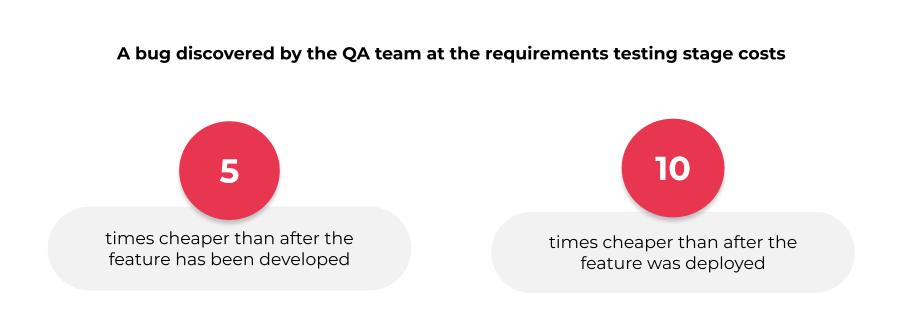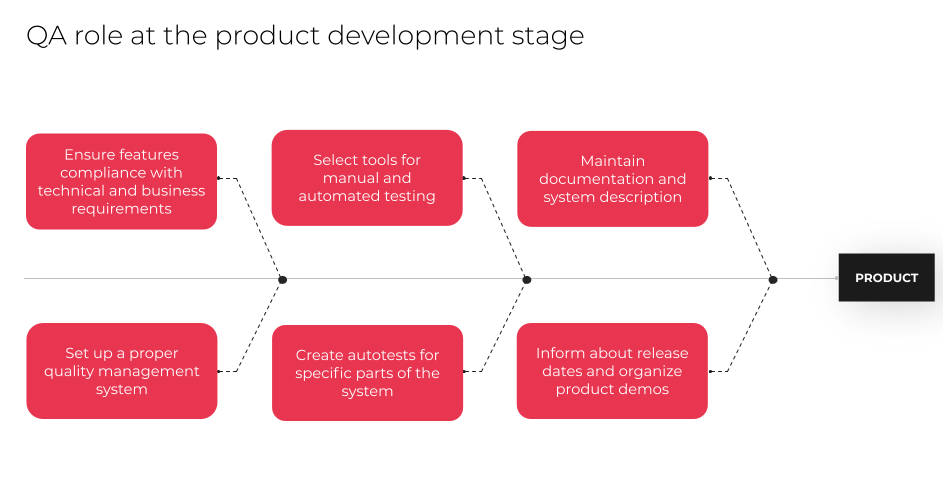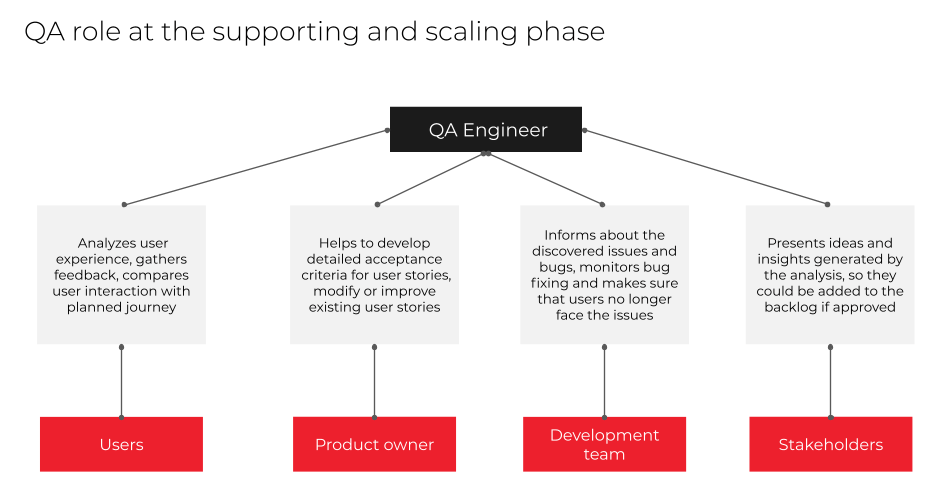Software Quality Assurance in the Product Development Life Cycle
There are two dangerous myths about software Quality Assurance and development:
- The product quality is a sole responsibility of the Quality Assurance team.
- QA team only checks if the features work correctly after the deployment.
Both of them are not true.
The entire development team is collectively responsible for the product quality. If development and testing do not occur side by side, it results in delays, inconsistency, and poor product quality. Development and testing should always run in-parallel.
The following is a breakdown of the software Quality Assurance team’s role in each stage of the product development life cycle.
Requirements Specification and Validation Stage
One of the most important tasks QA does is product requirements analysis. A bug discovered by the QA team at the requirements testing stage costs one fifth of what it would after development is complete, and one tenth of what it would cost to resolve following deployment.
So QA should never wait until development completes the feature. QA has to cooperate with the developer at the planning stage so they can plan possible testing cases in order to reduce testing time in the future and catch more bugs early.
QA role in the specification and validation stage
QA checks the terms of reference, analyzes business and technical requirements, and finds inconsistencies in them. They ask the fundamental question, “why is this necessary?” saving precious time. They need to understand business requirements well from a user perspective, because most test cases are based on using the application the way end users would.
At the initial stage, QA and the development teams discuss how to implement ideas and user stories from the backlog. QA specialists decide whether implementation of the selected solution will follow the stakeholders’ original plan or if changes would support a better user experience.
Finally, they provide feedback to the product owner based on their testing experience. This can help the product owner to understand the application better from the end-user perspective.
Product Development Stage
Software QA specialists take part in every stage of the product life cycle. They test functionality against the technical and business requirements from the beginning of product development and up to the support phase. They ensure the product solves specific business problems in the best way possible.
The goal of Quality Assurance is to improve the development and testing process and, therefore, to prevent bugs. Their approach includes setting up a proper quality management system, assessing its feasibility, and reviewing all involved operations.
QA Role at the Product Development Stage
The Quality Assurance engineer analyzes product needs and selects tools for manual and automated testing and documentation. QA should understand different tools in order to select the most appropriate one for the goals and needs of the product.
The team analyzes what tests can be automated to save time on routine tests that would otherwise require a lot of manual effort. If automated tests can be used, QA draws up a plan, and implements it. They prepare and maintain product documentation for future reference and smooth system development. They collect project metrics, analyze them and develop a plan for further product improvements.
The QA team informs the rest of the team about the current product state and the release dates. They also organize product demos for the stakeholders after each release.
Supporting and Scaling Phase
Once the product launches, QA collects feedback from users, customers, and employees of the client. They use that feedback to analyze the user experience, define areas for improvement, and validate the actual user interaction against the plan.
The key stakeholders approve the ideas and insights generated by this analysis before adding tasks to the backlog. And after the release of the product, QA monitors to ensure users no longer face the issues.
QA Role After the Product Launch
One of the primary responsibilities of a software Quality Assurance team is providing feedback to the product owner about their testing experience, as well as collecting feedback from the PO. QA works closely with the product owner to help develop detailed acceptance criteria for their user stories.
Based on what the team learns during each sprint, QA can also help the product owner modify or improve existing user stories to better reflect true requirements. As you can see, if done right the Quality Assurance has an important role at every stage of product development.
Now let’s dive a little deeper into who makes up a solid software Quality Assurance team and what’s required to establish one in-house or outsource the function.
Roles and responsibilities in QA teams: who does what
Quality assurance work requires a diverse set of skills and knowledge, so a QA team is made up of professionals who perform different tasks and have various responsibilities.
The roles are:
- The QA Lead supervises the team and controls all the software testing operations. They are responsible for testing strategy, resource planning, internal team communication, testing process estimation, and quality control of the work delivered by the team. The QA Lead is also responsible for external communication with a client or product owner to gather requirements for the future product, forwarding those requirements to the testing team, and ensuring full compliance with the requirements.
- The Test Architect designs complex test infrastructures and determines the necessary tools to meet the client’s demands and align with the team’s resources. This team member is responsible for the creation of a suitable test framework and is experienced both in automation and manual testing with a deep understanding of software architecture and system design. They also provide technical support to the QA team.
- The Test Analyst identifies test conditions and features that need to be tested based on knowledge of the intended product functionality and develops test scenarios and documentation. They are also responsible for systematization of the information to ease the work of QA Engineers.
- The Test Manager creates testing strategies and manages the team, the scope of work and the testing processes.
- The QA Engineer tests software to detect bugs and errors. They are responsible for checking whether a product complies with the requirements. This role is often broken down into three subsets:
- The Automation Tester develops automated testing and tests how a certain feature performs and how an isolated piece of code is implemented in the software. They rely on automated tools and have strong programming skills.
- The Manual Tester checks product performance by hand, mostly for the client-facing frontend of the software, which means checking the product as if it was being used by real customers.
- The UI/UX Tester ensures that the user experience is not changed for the worse with every new issue found and fixed. They are responsible for keeping the initially developed system design as polished in reality as it was on paper.
Establishing and managing a QA team is no small task. While some organizations choose to build their software Quality Assurance team in-house, many find that outsourcing the QA function makes more sense financially and logistically.
In-house vs Outsourced or Offshore QA Teams
When you start assembling a QA team for a new project, you have several options to choose from. You can hire an in-house team and build it from scratch or, if you already have one, you can augment it. Or you can use an outsourced QA team that is already established by a QA service provider.
Having an in-house QA team requires extensive onboarding. The size of the team and the roles required will depend on the specific project, product complexity, and business goals.
The more complex your project is, the more specialists with specific skills you will need to complete the project on time, and the more automated tools, too.
A remote or offshore QA team, on the other hand, puts all the responsibility of building and managing the QA team on your QA partner. Offshore QA teams are usually much less expensive than hiring full-time QA employees in your own country. A reputable provider will highly skilled and experienced testers who keep up with the necessary skills.
Another option is a hybrid remote-onsite model for companies that already have an in-house QA team and want to temporarily augment it with specific functions or specialists.
What you should know about effective in-house and offshore QA team management
If you have your own in-house QA team you have to:
- Explain your requirements and expectations clearly and set the roles and responsibilities for the team.
- Share your business goals so the team understands what you plan to achieve.
- Ensure continuous dialogue with your QA team.
- Ensure you get feedback if you don’t have enough information.
- Establish issue management processes and use management tools for documenting and tracking defects.
If you are thinking about outsourcing to a remote or offshore QA team, there are a few things you should keep in mind:
- Get to know your QA team members and their skills; appoint responsible team members, set realistic expectations for your team, and communicate those expectations clearly.
- Be a strong communicator and manage the language barrier. Arrange working schedules so that different time zones won’t be an obstacle.
- Arrange a realistic onshore-offshore balance and distribute the workload on the project based on the complexity of your business processes and accessibility constraints of the testing systems.
- Adapt your issue management process and use management tools for documenting and tracking defects that are accessible for your remote QA team. Choose a bug reporting program and task management software to ensure effective communication between teams.
- Manage the documentation on your deliverables properly – you have to develop a set of guidelines on document management covering test scenarios, test scripts, test execution, and results documentation.
- Have a clear plan in case of an emergency or tight deadlines.
Why Upgrade Your Software Quality Assurance Program?
A top-notch Quality Assurance team will help you:
- Save time using standardized processes and automation
- Boost your customer experience while delivering high-quality software with a user-friendly interface
- Increase customer satisfaction with a product that meets company standards and customer expectations
- Prevent expensive mistakes that result in unnecessary expense and damage to your reputation
You might need to consider hiring QA specialists, augmenting your in-house team, or outsourcing your QA work when:
- You have an in-house development team but from time to time it might need help to deliver faster or close gaps. Staff augmentation options provided by a reliable IT partner can help you address this issue. Outsourcing or augmenting your QA function will allow you to keep working efficiently through peak periods without having extra team members who are idle when demand is low.
- Your QA team has lost one or several members and you need to replace them as soon as possible to maintain the balance of the team and keep up with the development schedule.
- You want to speed up the execution of your in-house projects and need additional specialists to get things done.
- Your in-house team lacks necessary technical expertise and upskilling will take too long in the short term.
- You’ve maxed out your automation in-house – you’ve automated everything you can and there is still too much manual work that needs to be done. Transitioning QA teams to automation accelerates time to market.
Explore Cprime’s team augmentation and outsourced IT services or click below to read about a leading SaaS company who saw incredible results working with us.






